Portal:Viruses
The Viruses Portal
Welcome!
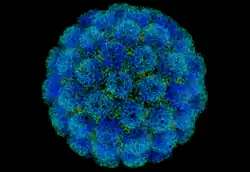
Viruses are small infectious agents that can replicate only inside the living cells of an organism. Viruses infect all forms of life, including animals, plants, fungi, bacteria and archaea. They are found in almost every ecosystem on Earth and are the most abundant type of biological entity, with millions of different types, although only about 6,000 viruses have been described in detail. Some viruses cause disease in humans, and others are responsible for economically important diseases of livestock and crops.
Virus particles (known as virions) consist of genetic material, which can be either DNA or RNA, wrapped in a protein coat called the capsid; some viruses also have an outer lipid envelope. The capsid can take simple helical or icosahedral forms, or more complex structures. The average virus is about 1/100 the size of the average bacterium, and most are too small to be seen directly with an optical microscope.
The origins of viruses are unclear: some may have evolved from plasmids, others from bacteria. Viruses are sometimes considered to be a life form, because they carry genetic material, reproduce and evolve through natural selection. However they lack key characteristics (such as cell structure) that are generally considered necessary to count as life. Because they possess some but not all such qualities, viruses have been described as "organisms at the edge of life".
Selected disease
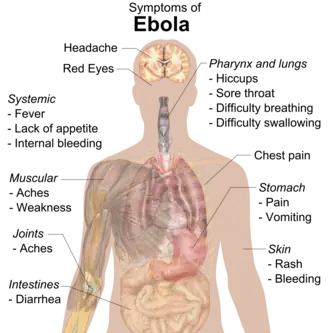
Ebola virus disease is a viral haemorrhagic fever of humans and other primates caused by ebolaviruses, RNA viruses in the Filoviridae family. The natural host is thought to be megabats. The virus spreads by contact with body fluids, such as blood. After an incubation period of 2–21 days, nonspecific symptoms including fever, sore throat, muscle pain and headache develop, followed by vomiting, diarrhoea, rash, liver and kidney impairment, and sometimes internal or external bleeding. On average, around half of those infected die, often from hypovolaemic shock. The virus sometimes persists in semen or breast milk for several weeks or months after recovery.
The disease was first identified in 1976 by Peter Piot and others in two simultaneous outbreaks, one in Nzara, Sudan and the other in Yambuku, then in Zaire, near the Ebola River, for which the disease is named. Outbreaks have occurred intermittently in tropical regions of sub-Saharan Africa, with a few thousand cases documented before the epidemic in Western Africa of 2013–16, in which nearly 29,000 cases with more than 11,000 deaths were reported. More than 3000 cases were documented in a subsequent epidemic in the Democratic Republic of the Congo in 2018–20, with more than 2000 deaths. Prevention of outbreaks focuses on limiting virus transmission from infected animals to humans, for example, by taking precautions when handling bush meat. Ebola vaccines are now available. Monoclonal antibody treatments can improve outcomes, and a combination of three monoclonals has been licensed.
Selected image
Muhammad ibn Zakariya al-Razi was a Persian physician and chemist who, in the 9th century, was the first to document the distinction between the diseases of measles and smallpox.
Credit: Gerard of Cremona (c. 1250–60)
In the news

26 February: In the ongoing pandemic of severe acute respiratory syndrome coronavirus 2 (SARS-CoV-2), more than 110 million confirmed cases, including 2.5 million deaths, have been documented globally since the outbreak began in December 2019. WHO
18 February: Seven asymptomatic cases of avian influenza A subtype H5N8, the first documented H5N8 cases in humans, are reported in Astrakhan Oblast, Russia, after more than 100,0000 hens died on a poultry farm in December. WHO
14 February: Seven cases of Ebola virus disease are reported in Gouécké, south-east Guinea. WHO
7 February: A case of Ebola virus disease is detected in North Kivu Province of the Democratic Republic of the Congo. WHO
4 February: An outbreak of Rift Valley fever is ongoing in Kenya, with 32 human cases, including 11 deaths, since the outbreak started in November. WHO
21 November: The US Food and Drug Administration (FDA) gives emergency-use authorisation to casirivimab/imdevimab, a combination monoclonal antibody (mAb) therapy for non-hospitalised people twelve years and over with mild-to-moderate COVID-19, after granting emergency-use authorisation to the single mAb bamlanivimab earlier in the month. FDA 1, 2
18 November: The outbreak of Ebola virus disease in Équateur Province, Democratic Republic of the Congo, which started in June, has been declared over; a total of 130 cases were recorded, with 55 deaths. UN
Selected article
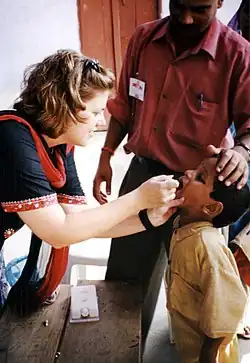
Vaccination or immunisation is the administration of immunogenic material (a vaccine) to stimulate an individual's immune system to develop adaptive immunity to a virus or other pathogen, and so develop protection against an infectious disease. The active agent of a vaccine may be intact but inactivated or weakened forms of the pathogen, or purified highly immunogenic components, such as viral envelope proteins. Smallpox was the first disease for which a vaccine was produced, by Edward Jenner in 1796.
Vaccination is the most effective method of preventing infectious diseases and can also ameliorate the symptoms of infection. When a sufficiently high proportion of a population has been vaccinated, herd immunity results. Widespread immunity due to mass vaccination is largely responsible for the worldwide eradication of smallpox and the elimination of diseases such as polio from much of the world. Since their inception, vaccination efforts have met with objections on scientific, ethical, political, medical safety and religious grounds, and the World Health Organization considers vaccine hesitancy an important threat to global health.
Selected outbreak

The last recorded smallpox death occurred during the 1978 smallpox outbreak in Birmingham, UK. The outbreak resulted from accidental exposure to the Abid strain of Variola major, from a laboratory, headed by Henry Bedson, at the University of Birmingham Medical School – also associated with an outbreak in 1966. Bedson was investigating strains of smallpox known as whitepox, considered a potential threat to the smallpox eradication campaign, then in its final stages.
A medical photographer who worked on the floor above the laboratory showed smallpox symptoms in August and died the following month; one of her contacts was also infected but survived. The government inquiry into the outbreak concluded that she had been infected in late July, possibly via ducting, although the precise route of transmission was subsequently challenged. The inquiry criticised the university's safety procedures. Bedson committed suicide while under quarantine. Radical changes in UK research practices for handling dangerous pathogens followed, and all known stocks of smallpox virus were concentrated in two laboratories.
Selected quotation
| “ | ...classical approaches to classification are not suitable for viruses, as rigid hierarchies cannot be imposed on organisms that appear – evolutionarily speaking – to have been rather promiscuous in sharing their characteristics around. | ” |
—Ed Rybicki
Recommended articles
Viruses & Subviral agents: bat virome • elephant endotheliotropic herpesvirus • HIV • introduction to viruses![]() • Playa de Oro virus • poliovirus • prion • rotavirus
• Playa de Oro virus • poliovirus • prion • rotavirus![]() • virus
• virus![]()
Diseases: colony collapse disorder • common cold • croup • dengue fever![]() • gastroenteritis • Guillain–Barré syndrome • hepatitis B • hepatitis C • hepatitis E • herpes simplex • HIV/AIDS • influenza
• gastroenteritis • Guillain–Barré syndrome • hepatitis B • hepatitis C • hepatitis E • herpes simplex • HIV/AIDS • influenza![]() • meningitis
• meningitis![]() • myxomatosis • polio
• myxomatosis • polio![]() • pneumonia • shingles • smallpox
• pneumonia • shingles • smallpox
Epidemiology & Interventions: 2007 Bernard Matthews H5N1 outbreak • Coalition for Epidemic Preparedness Innovations • Disease X • 2009 flu pandemic • HIV/AIDS in Malawi • polio vaccine • Spanish flu • West African Ebola virus epidemic
Virus–Host interactions: antibody • host • immune system![]() • parasitism • RNA interference
• parasitism • RNA interference![]()
Methodology: metagenomics
Social & Media: And the Band Played On • Contagion • "Flu Season" • Frank's Cock![]() • Race Against Time: Searching for Hope in AIDS-Ravaged Africa
• Race Against Time: Searching for Hope in AIDS-Ravaged Africa![]() • social history of viruses
• social history of viruses![]() • "Steve Burdick" • "The Time Is Now" • "What Lies Below"
• "Steve Burdick" • "The Time Is Now" • "What Lies Below"
People: Brownie Mary • Macfarlane Burnet![]() • Bobbi Campbell • Aniru Conteh • people with hepatitis C
• Bobbi Campbell • Aniru Conteh • people with hepatitis C![]() • HIV-positive people
• HIV-positive people![]() • Bette Korber • Henrietta Lacks • Linda Laubenstein • Barbara McClintock
• Bette Korber • Henrietta Lacks • Linda Laubenstein • Barbara McClintock![]() • poliomyelitis survivors
• poliomyelitis survivors![]() • Joseph Sonnabend • Eli Todd • Ryan White
• Joseph Sonnabend • Eli Todd • Ryan White![]()
Selected virus
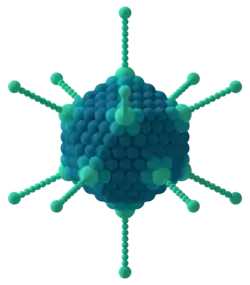
Adenoviruses are a group of non-enveloped DNA viruses that make up the Adenoviridae family. At 90–100 nm in diameter, they are the largest known viruses to lack an envelope. Unique spikes or fibres protrude from the icosahedral capsid, with knobs that bind to the receptor on the host cell. The linear double-stranded genome is 26 to 48 kb long, encodes 23 to 46 proteins, and has a 55 kDa protein attached to each end.
Adenoviruses infect a broad range of vertebrates, including humans, livestock, horses, dogs, bats and other mammals, as well as birds and reptiles, and usually cause infections of the upper respiratory tract. The virus is very stable. Transmission can occur by respiratory droplets or via faeces, with swimming pools being a common source of infection. A total of 57 serotypes, grouped into 7 species, have been found in humans; they cause a wide range of illnesses including mild respiratory infections, conjunctivitis and gastroenteritis. Some types have been associated with obesity. In people with an immunodeficiency they can cause life-threatening multi-organ disease. No antiviral treatment or vaccine is generally available; hand washing is the best way to prevent infection. Adenoviruses are an important viral vector for gene therapy. An oncolytic adenovirus has been approved in China for the treatment of head and neck cancer.
Did you know?
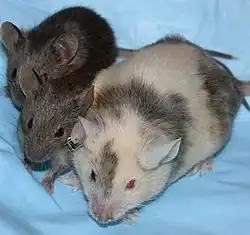
- ...that in 1974, Rudolf Jaenisch and Beatrice Mintz created the first transgenic mouse (example pictured) by injecting DNA from simian virus 40?
- ...that double-stranded RNA viruses cause everything from gastroenteritis in young children to bluetongue disease in livestock?
- ...that Inventing the AIDS Virus, written by molecular biologist Peter Duesberg, argues that AIDS is not infectious and that HIV is an unrelated passenger virus?
- ...that proteins from pokeweed have shown antiviral properties?
- ...that Gabriel Scally of the Independent SAGE committee has described the British government's response to the COVID-19 pandemic as "too little, too late, too flawed"?
Selected biography
George Keble Hirst (2 March 1909 – 22 January 1994) was an American virologist who was among the first to study the molecular biology and genetics of animal viruses.
Hirst started to work on influenza virus in 1940, only a few years after it had been isolated. He soon discovered that the virus caused red blood cells to clump together. This phenomenon could be used to diagnose influenza, which had previously required growing the virus in ferrets. He invented the haemagglutination assay, a simple method for quantifying viruses, and later the haemagglutination inhibition assay, which measures virus-specific antibodies in serum. In 1942, he discovered the neuraminadase enzyme, showing for the first time that viruses could contain enzymes. Neuraminidase is the target of the neuraminidase inhibitor class of antiviral drugs, including oseltamivir and zanamivir. In 1962, he was also the first to propose the then-revolutionary idea that virus genomes can consist of discontinuous segments.
He co-founded Virology in 1955, the first English-language journal to focus on viruses, and directed the Public Health Research Institute in New York City for nearly 25 years (1956–81).
In this month
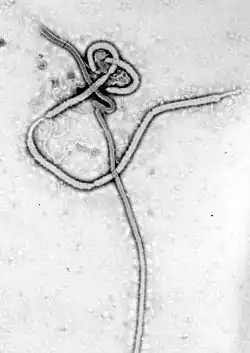
1 August 1971: The term viroid was coined by Theodor Diener to describe the agent of potato spindle tuber disease
6 August 2007: Maraviroc, first CCR5 receptor antagonist, approved for HIV/AIDS
8 August 2011: UN declared rinderpest eradicated
8 August 2014: WHO declared the Ebola outbreak in West Africa (virus pictured), the most widespread so far, an international public health emergency
18 August 1990: Ryan White Care Act enacted, the largest American federally funded programme for people living with HIV/AIDS
20 August 1780: Start of an outbreak of dengue fever in Philadelphia, USA, which led Benjamin Rush to describe the disease in 1789
26 August 1976: First case of Ebola virus, now the Zaire form
26 August 1998: Fomivirsen, first antisense drug, approved for cytomegalovirus retinitis
Selected intervention
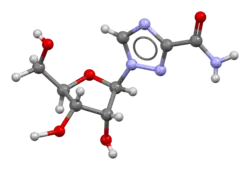
Ribavirin is a nucleoside analogue that mimics the nucleoside guanosine. It shows some activity against a broad range of DNA and RNA viruses, but is less effective against dengue fever, yellow fever and other flaviviruses. The drug was first synthesised in the early 1970s by Joseph T. Witkowski and Roland K. Robins. Ribavirin's main current use is against hepatitis C, in combination with pegylated interferon, nucleotide analogues and protease inhibitors. It has been used in the past in an aerosol formulation against respiratory syncytial virus-related diseases in children. Ribavirin has been used in combination as part of an experimental treatment for rabies. It is also the only available treatment for the viruses causing some viral haemorrhagic fevers, including Lassa fever, Crimean–Congo haemorrhagic fever and hantavirus disease, but is ineffective against the filovirus diseases, Ebola and Marburg. Clinical use is limited by the drug building up in red blood cells to cause haemolytic anaemia.
Subcategories
Subcategories of virology:
Topics
Things to do
- Comment on what you like and dislike about this portal
- Join the Viruses WikiProject
- Tag articles on viruses and virology with the project banner by adding {{WikiProject Viruses}} to the talk page
- Assess unassessed articles against the project standards
- Create requested pages: red-linked viruses | red-linked virus genera
- Expand a virus stub into a full article, adding images, citations, references and taxoboxes, following the project guidelines
- Create a new article (or expand an old one 5-fold) and nominate it for the main page Did You Know? section
- Improve a B-class article and nominate it for Good Article
 or Featured Article
or Featured Article status
status - Suggest articles, pictures, interesting facts, events and news to be featured here on the portal
WikiProjects & Portals
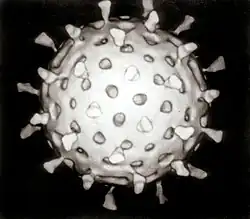 WikiProject Viruses
Related WikiProjects
WikiProject Viruses
Related WikiProjects
Medicine • Microbiology • Molecular & Cellular Biology • Veterinary Medicine
Related PortalsAssociated Wikimedia
The following Wikimedia Foundation sister projects provide more on this subject:
-
Commons
Free media repository -
Wikibooks
Free textbooks and manuals -
Wikidata
Free knowledge base -
Wikinews
Free-content news -
Wikiquote
Collection of quotations -
Wikisource
Free-content library -
Wikispecies
Directory of species -
Wikiversity
Free learning tools -
Wiktionary
Dictionary and thesaurus








